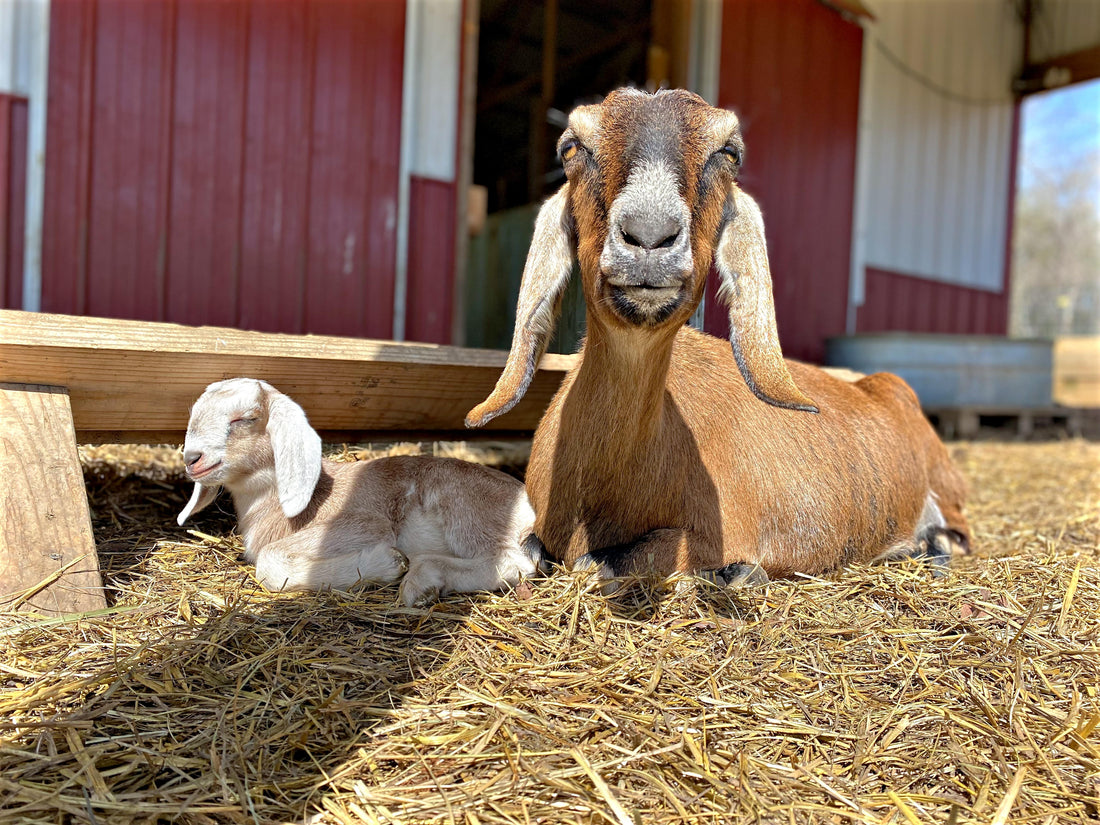
What is in our Kidding Kit?
Share
You have waited 5 long months. Heck, you may have been waited for years! This might be your first time have goat kids born on your homestead/farm. All the more reason to be prepared ahead of time.
The age old saying goes something like- it just takes one emergency to realize how UNprepared you are. We don’t want you to be in that position.
On the flip side I will tell you that goats have kids in fields with no human interaction and do just fine. There is a fine line between letting nature be and hovering.
Prior to breeding, or while your goats are still pregnant become familiar with the most common pregnancy related complications/disease processes:
Pregnancy Toxemia (BEFORE KIDDING): a metabolic condition where the doe has excess ketones in the blood/body (urine and milk) due to incomplete breakdown of body fat. Sometimes this can be caused by lack of grain OR too much grain OR poor quality hay.
Ketosis (AFTER KIDDING) : Ketosis after kidding is fairly rare and we have never experienced it here on our homestead, however we have helped others nearby. Ketosis is a metabolic condition that occurs after the goat kids. The body has such a high demand to feed the kids/produce milk and we have to support the doe in doing so. This would be more common with multiple fetuses.
For both, you want to ensure that the doe is not overweight, but not underweight either. Don’t limit exercise, even in late gestation. A lot of folks have the tendency to lock the does up once they get close to keep an eye on them. Find a better way. :)
Hypocalcaemia: Low calcium/nutrition needs are not being met.
Research a bit more than what I have provided, these are VERY abbreviated illustrations of what these might look like. Being prepared is best! There is a very good chance you won't run into any of the above.
If nothing else have your vets phone number handy and have a good relationship with them BEFORE the goats kid. Trust me, I (Mandi, RVT) have worked in veterinary medicine for 20 years and client/patient relationships are crucial in these situations. You may not be the only emergency and if the clinic has to choose where to go they are likely to go where they are familiar first. Harsh reality, but someone has to be first. Make it a point to get to know they staff and let them know what your operation is working with.
Okay! I am going to give a rundown of what we have in our kidding kit. I will try to be an inclusive as possible.
Remember this, animals including goats have been having kids for many years with NO human interaction and are just fine. If you don’t have access to all of this don’t panic. I will put the key things first and anything after that would be “nice” to have but not essential.
#1 Goat colostrum. We save some year after year, however if this is your first kidding they sell it in powder form at any feed store. Even Amazon. You should have some milk replacer on hand too.
-Old (clean) towels and or potty pads
-Gloves in case you need to assist- I will say this, I would much rather wash my hands on site and NOT wear gloves. But you MUST have clean hands.
-Betadine dip or spray for the navel after the kids are born- if you can’t find this or don’t have any a diluted chlorhexidine or wound spray would be second best.
-NurtiDrench or something of the like
-STAT- this is a calorie booster that can be given to the doe AND the kid if needed. It’s smells like cookie doe and they love it
-A BLOW DRYER- not necessary if you kid in warm weather but we absolutely DO NOT recommend putting heat lamps in your barn at all. If you know when the kidding date is, you can try to be there (cameras!!) and blow-dry the kids. They do fine with good shelter if they are dry and not chilled.
-Dental floss or something similar to tie the umbilical cord IF it is too long. We will dip ours in Betadine but I have only tied a few in my lifetime. Most often the cord will rip close enough to the body or the doe will aid in making it smaller.
If you only had those things, you would be just fine.
Other things to keep on hand:
Thermometer, but you should have this already
Syringes for drenching (or who knows what else)
Flashlight
Bottle with correct nipples for small kids
We like to give our does warm water with molasses right after they kid to thank them and also to jump start that rumen again and get them eating. We will feed them and give them free choice hay once they have cleaned the kids off.
The kids should be up and nursing quickly, most of the time within 10-30 minutes. We never leave the barn until I see them nurse at least twice to ensure they have colostrum. Then we let the new family bond and do life!
Few things to remember:
Know and have a good relationship with your vet
Have the few essential things on hand if you can
Know your breeding dates
Take deep breaths and don’t panic. Most of the time you just get to witness the magic.
As always, if there are any questions you can find us on Instagram @wildoakfarms
Cheers